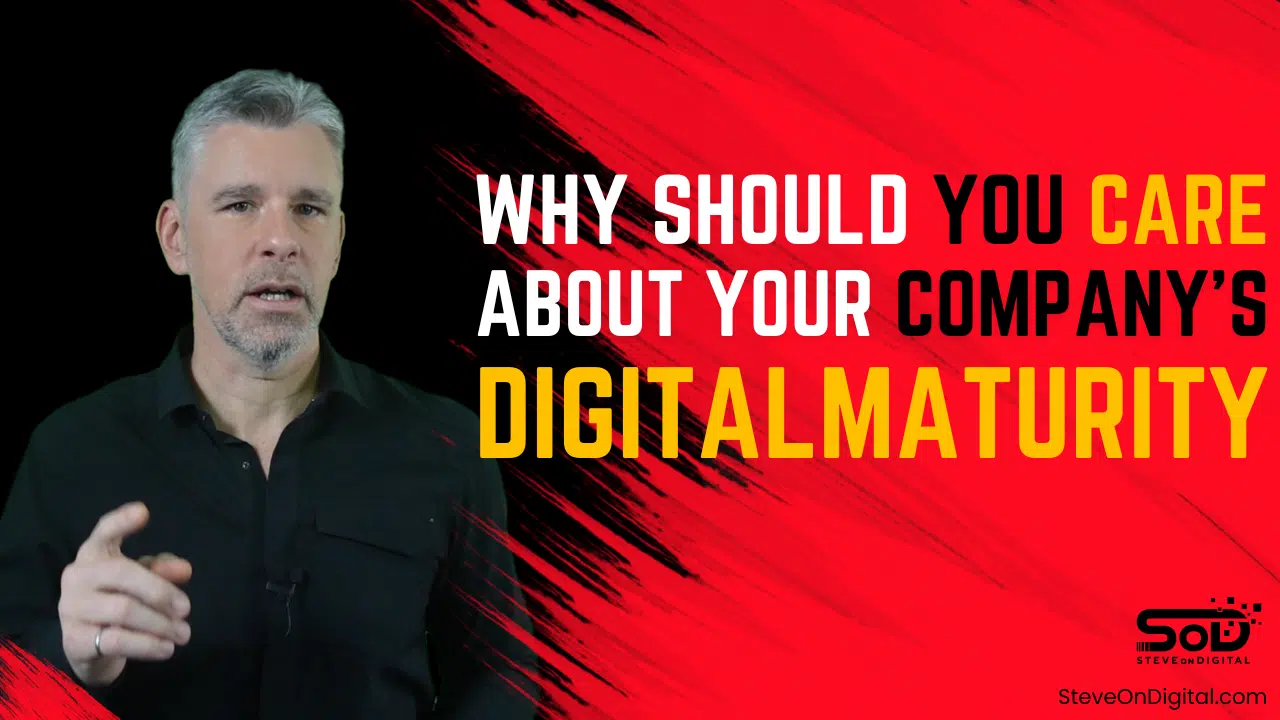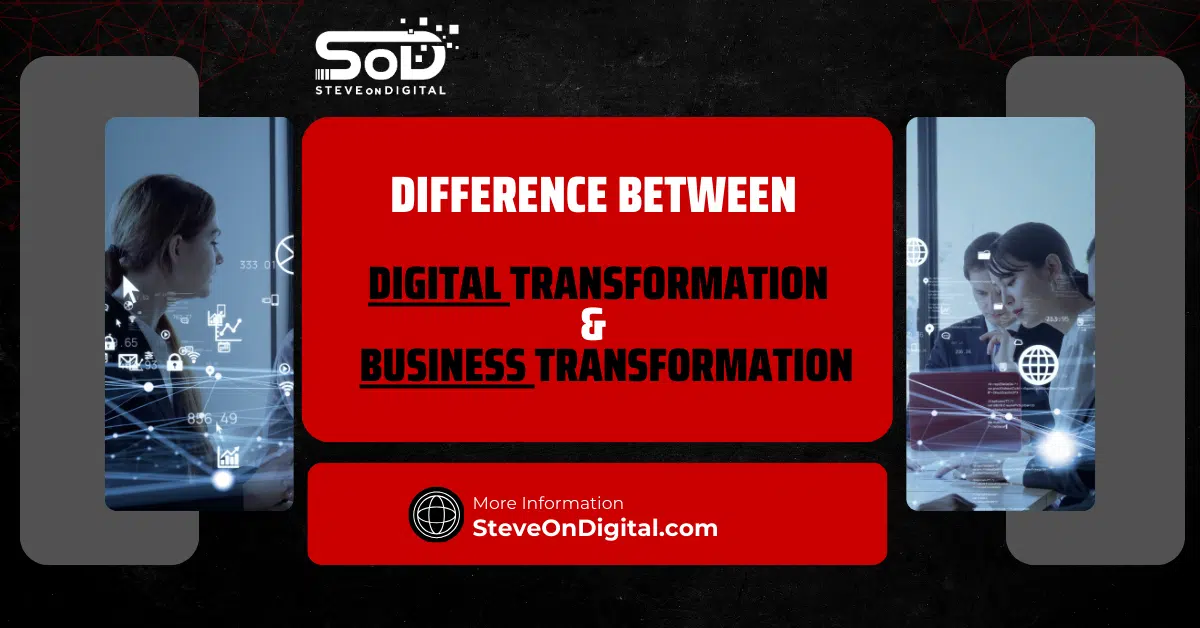Digital maturity refers to how well a business uses digital technologies to improve its operations, culture, and customer experiences, leading to business growth and value. It involves adopting advanced technologies, optimizing processes, and fostering a culture that embraces continuous learning and innovation.
Understanding and achieving digital maturity is essential for staying competitive. Companies that invest in digital transformation see increased revenue and market share. For instance, 89% of companies have adopted or plan to adopt a digital-first strategy, showing the growing importance of digital initiatives in today’s business landscape (Digital Adoption) (Kissflow Platform).
I’m Steve, a digital transformation expert with a strong background in electrical engineering, an MBA, and a master’s in Project Management. I excel at helping SMEs navigate the digital landscape with practical insights. Let’s begin!
Digital Maturity: An In-Depth Exploration
Digital maturity refers to the extent to which an organization utilizes digital technologies to enhance its processes, culture, and customer experiences, ultimately driving business value and growth. This comprehensive guide explores the nuances of digital maturity and provides actionable insights for small business owners to navigate their digital transformation journey.
Understanding Digital Maturity
Digital maturity is about how well a business integrates digital technologies into its operations. It encompasses the adoption of advanced technologies, process optimization, and cultural transformation to meet the evolving needs of customers and market demands.
Importance Of Digital Maturity
Achieving digital maturity is crucial for staying competitive. Companies that invest in digital transformation see significant benefits, such as increased revenue and market share. For instance, 89% of companies have adopted or plan to adopt a digital-first strategy, showing the growing importance of digital initiatives in today’s business landscape (Digital Adoption) (Kissflow Platform).
Key Elements Of Digital Maturity
- Technology Adoption: Integrating digital tools and technologies to streamline operations and enhance productivity.
- Process Optimization: Improving business processes through automation and data-driven decision-making.
- Cultural Transformation: Fostering a digital culture that embraces innovation and continuous learning.
Digital Maturity Models
Digital maturity models are frameworks that help businesses assess their digital capabilities and identify areas for improvement.
Overview Of Digital Maturity Models
These models provide a structured approach to evaluate an organization’s current digital maturity level and guide their transformation journey. They typically cover various dimensions, such as technology, strategy, operations, and culture (Whatfix).
Popular Digital Maturity Models
- Boston Consulting Group’s Digital Acceleration Index (DAI): This model benchmarks a company’s digital capabilities against industry standards, helping businesses identify gaps and track progress (Whatfix).
| Model Name | Key Dimensions Covered | Description | Source |
| Boston Consulting Group’s DAI | Technology, Strategy, Operations | Benchmarks company’s digital capabilities against industry standards | Whatfix |
| Deloitte’s Digital Maturity Model | Customer, Strategy, Technology, Operations, Culture | Comprehensive assessment focusing on data to maximize business value | Whatfix |
- Deloitte’s Digital Maturity Model: Covers five core dimensions—customer, strategy, technology, operations, and culture—with an additional focus on data to maximize business value (Whatfix).
Benefits Of Using Digital Maturity Models
Using these models helps organizations:
- Track their digital transformation progress.
- Identify areas needing improvement.
- Make informed decisions on digital investments (Whatfix).
Stages Of Digital Maturity
Digital maturity progresses through several stages, from initial awareness to full digital integration and innovation.
Initial Stage: Digital Awareness
At this stage, businesses recognize the importance of digital transformation and begin exploring digital tools and strategies. Most organizations start here due to technological disruptions that necessitate change (Whatfix).
Intermediate Stage: Digital Integration
Businesses at this stage integrate digital technologies into their core processes, enhancing efficiency and collaboration. They develop a clear digital strategy and begin scaling their initiatives across the organization (Whatfix).
Advanced Stage: Digital Innovation
In this stage, businesses lead in digital innovation, using advanced technologies like artificial intelligence and data analytics to drive growth and competitive advantage. They continuously optimize their digital processes and culture (Whatfix).
Assessing Digital Maturity
Assessing an organization’s digital maturity is essential for understanding its current capabilities and planning future initiatives. This assessment helps businesses identify strengths, weaknesses, and areas for improvement, guiding their digital transformation efforts effectively.
Digital Maturity Assessment Tools
To evaluate digital maturity, various tools and methods are available. These tools provide insights into different aspects of digital capabilities, helping organizations measure their progress.
- Boston Consulting Group’s Digital Acceleration Index (DAI): This tool benchmarks an organization’s digital capabilities against industry standards, offering a clear picture of where they stand compared to peers (Whatfix).
- Deloitte’s Digital Maturity Model: It covers five core dimensions—customer, strategy, technology, operations, and culture—providing a comprehensive assessment of digital maturity (Whatfix).
- Self-Assessment Surveys: Tools like online surveys and questionnaires that help businesses self-evaluate their digital maturity by answering a series of targeted questions.
| Tool Name | Purpose | Key Features | Source |
| Boston Consulting Group’s DAI | Benchmarks against industry standards | Clear picture of current digital capabilities | Whatfix |
| Deloitte’s Digital Maturity Model | Comprehensive assessment | Focuses on customer, strategy, and technology | Whatfix |
| Self-Assessment Surveys | Self-evaluation of digital maturity | Series of targeted questions | Whatfix |
Conducting A Digital Maturity Assessment
Performing a digital maturity assessment involves several steps:
- Define Objectives: Clearly outline what you aim to achieve with the assessment. This could include identifying gaps, planning digital initiatives, or benchmarking against competitors.
- Select Assessment Tools: Choose the appropriate tools based on your objectives and the aspects of digital maturity you wish to evaluate.
- Gather Data: Collect data from various departments, including IT, marketing, and operations. This data should reflect current digital capabilities and practices.
- Analyze Results: Evaluate the data to identify strengths, weaknesses, and areas for improvement. Look for patterns and insights that can inform your digital strategy.
- Create a Report: Summarize the findings in a comprehensive report that includes actionable recommendations for enhancing digital maturity.
Using Assessment Results For Improvement
Leveraging the outcomes of your digital maturity assessment can drive meaningful improvements in your digital transformation journey:
- Identify Quick Wins: Focus on areas that can be improved rapidly to gain immediate benefits.
- Develop a Roadmap: Use the insights to create a detailed digital transformation roadmap, outlining short-term and long-term goals.
- Allocate Resources: Ensure adequate resources are allocated to high-priority areas identified in the assessment.
- Monitor Progress: Regularly track progress against the roadmap and make adjustments as needed to stay on course.
Digital Transformation Journey
The digital transformation journey involves a series of strategic initiatives aimed at enhancing an organization’s digital capabilities. This journey is essential for adapting to the digital age and staying competitive.
Planning The Digital Transformation Journey
Developing a digital transformation roadmap is a critical step. Key considerations include:
- Set Clear Goals: Define what success looks like for your organization in terms of digital transformation.
- Engage Stakeholders: Involve key stakeholders from various departments to ensure buy-in and support.
- Identify Key Technologies: Determine which digital technologies will drive your transformation efforts.
- Allocate Budget and Resources: Ensure you have the necessary budget and resources to support your initiatives.
- Create a Timeline: Establish a realistic timeline with milestones to track progress.
Implementing Digital Transformation Initiatives
Executing digital transformation projects requires careful planning and execution:
- Pilot Projects: Start with small pilot projects to test new technologies and approaches.
- Scale Up: Once pilot projects are successful, scale them up across the organization.
- Continuous Improvement: Regularly review and refine digital initiatives to ensure they continue to deliver value.
- Employee Training: Provide ongoing training to employees to help them adapt to new digital tools and processes.
Overcoming Challenges In The Digital Transformation Journey
Common obstacles during digital transformation include:
- Resistance to Change: Communicate the benefits of digital transformation clearly and involve employees in the process to address resistance effectively.
- Data Silos: Break down data silos by integrating data across departments and ensuring it is accessible to those who need it.
- Legacy Systems: Modernize legacy systems to support new digital initiatives.
- Resource Constraints: Allocate resources strategically and seek external partnerships if necessary.
Key Digital Technologies
Digital technologies play a pivotal role in achieving digital maturity and driving business growth. Understanding and integrating these technologies is crucial for any digital transformation effort.
Role Of Artificial Intelligence
Artificial intelligence (AI) technologies contribute significantly to digital maturity by:
- Automating Processes: AI can automate routine tasks, freeing up employees to focus on more strategic activities.
- Enhancing Decision-Making: AI-driven data analytics provide insights that support better business decisions.
- Improving Customer Experience: AI-powered chatbots and personalized recommendations enhance customer satisfaction.
Importance Of Data Analytics
Data analytics is essential for business decision-making and performance:
- Gaining Insights: Analyzing data helps businesses understand customer behavior, market trends, and operational efficiency.
- Optimizing Processes: Data-driven insights can identify areas for process improvements and cost savings.
- Measuring Performance: Analytics provide metrics to measure the success of digital initiatives and guide future strategies.
Integrating New Technologies
Incorporating advanced technologies into existing business processes involves:
- Assessing Current Capabilities: Evaluate your current technology infrastructure to identify gaps.
- Choosing the Right Technologies: Select technologies that align with your business goals and needs.
- Planning Integration: Develop a detailed plan for integrating new technologies, including timelines, resources, and potential challenges.
- Training Employees: Provide comprehensive training to ensure employees can effectively use new technologies.
By following these guidelines, you can successfully assess your digital maturity and navigate your digital transformation journey, leveraging key technologies to drive business growth and competitiveness.
Digital Leadership and Culture
Strong digital leadership and a supportive culture are vital for fostering digital maturity. My journey through digital transformation has taught me the importance of these elements firsthand.
Developing Digital Leadership Skills
Effective digital leaders need a specific set of skills and attributes:
- Vision and Strategy: Leaders must have a clear vision for the future and the ability to craft strategies that align with that vision. This involves understanding digital technologies and how they can be leveraged to achieve business goals.
- Adaptability: The digital landscape is constantly changing. Leaders must be adaptable, willing to learn, and open to new ideas. This skill has helped me stay ahead in the digital game, especially when new technologies emerge.
- Communication: Clear and effective communication is crucial. Leaders must be able to convey their vision and strategy to all stakeholders, ensuring everyone is on the same page. I’ve found that regular updates and open dialogues with my team help maintain alignment and motivation.
Promoting a Digital Culture
Cultivating a culture that embraces digital transformation involves several strategies:
- Encourage Innovation: Foster an environment where new ideas are welcomed and experimentation is encouraged. This can be achieved through initiatives like hackathons or innovation labs.
- Continuous Learning: Promote continuous learning and development. Provide access to training programs and resources that help employees develop their digital skills. Personally, I always make it a point to attend workshops and seminars to stay updated and share my learnings with my team.
- Collaboration: Break down silos and promote cross-functional collaboration. Use digital tools to facilitate communication and collaboration across teams. Tools like Slack and Trello have been invaluable in keeping my team connected and productive.
Role of Leadership in Digital Maturity
Leadership plays a crucial role in influencing the organization’s digital maturity level:
- Setting the Tone: Leaders set the tone for the entire organization. By embracing digital transformation and leading by example, they inspire others to follow suit.
- Resource Allocation: Effective leaders ensure that adequate resources are allocated to digital initiatives. This includes investing in technology, training, and hiring skilled personnel.
- Monitoring Progress: Leaders must regularly monitor progress and make adjustments as needed. This involves setting key performance indicators (KPIs) and using data analytics to track the success of digital initiatives.
Digital Strategy and Planning
A well-defined digital strategy is crucial for guiding an organization’s digital transformation efforts.
Creating a Digital Strategy
Formulating a comprehensive digital strategy involves several steps:
- Assess Current State: Evaluate your current digital capabilities and identify gaps. This assessment helps in understanding where you stand and what needs improvement.
- Define Goals: Set clear, measurable goals for what you want to achieve through digital transformation. These goals should align with your overall business objectives.
- Identify Key Technologies: Determine which digital technologies will help you achieve your goals. For instance, if improving customer experience is a priority, investing in AI and data analytics might be beneficial.
- Develop a Roadmap: Create a detailed roadmap outlining the steps needed to achieve your goals. This should include timelines, resource allocation, and key milestones.
Aligning Digital Strategy with Business Goals
Ensuring that the digital strategy supports and enhances overall business objectives is crucial:
- Integration with Business Plans: The digital strategy should be integrated with the broader business plan. This ensures that all digital initiatives support the company’s mission and vision.
- Stakeholder Involvement: Involve key stakeholders in the strategy development process. This ensures buy-in and alignment across the organization.
- Regular Reviews: Regularly review and adjust the digital strategy to ensure it remains aligned with business goals. This is something I do frequently to ensure my strategies are always relevant and effective.
Monitoring and Adjusting the Digital Plan
Tracking the progress of the digital strategy and making necessary adjustments is key:
- Set KPIs: Establish performance metrics to gauge the success of your digital initiatives. These could include metrics like customer satisfaction, operational efficiency, and revenue growth.
| KPI | Description | Measurement Criteria |
| Customer Satisfaction | Measures how satisfied customers are with products/services | Net Promoter Score (NPS), Customer Satisfaction Score (CSAT) |
| Operational Efficiency | Assesses the efficiency of business operations | Time saved, cost reduction |
| Revenue Growth | Tracks the increase in revenue due to digital initiatives | Percentage increase in sales |
| Innovation Index | Evaluates the level of innovation within the organization | Number of new products/services introduced |
- Use Data Analytics: Leverage data analytics to gain insights into the performance of your digital initiatives. This helps in making informed decisions and adjustments.
- Continuous Improvement: Adopt a mindset of continuous improvement. Regularly evaluate what’s working and what’s not, and be willing to pivot as needed.
Digital Innovation and Solutions
Innovation is a key driver of digital maturity, enabling organizations to stay ahead in a competitive market.
Fostering Digital Innovation
Encouraging innovation within an organization involves:
- Creating an Innovation Lab: Establish a dedicated space for experimenting with new ideas and technologies. This can help foster a culture of innovation and creativity.
- Encouraging Collaboration: Promote cross-functional collaboration to bring diverse perspectives and ideas to the table. Collaboration tools like Microsoft Teams can facilitate this process.
- Rewarding Innovation: Recognize and reward employees who come up with innovative solutions. This motivates others to think creatively and contribute to the organization’s success.
Implementing Digital Solutions
Adopting and integrating digital solutions to enhance business operations involves:
- Identifying Needs: Assess the specific needs of your business operations and identify digital solutions that can address those needs. For example, implementing a CRM system to improve customer relationship management.
- Pilot Testing: Start with a pilot test to evaluate the effectiveness of the digital solution. This helps in identifying any issues and making necessary adjustments before a full-scale rollout.
- Training and Support: Provide comprehensive training and support to ensure employees can effectively use the new digital solutions. This is crucial for a smooth transition and successful implementation.
Measuring the Impact of Digital Solutions
Evaluating the effectiveness of digital solutions involves:
- Tracking KPIs: Monitor key performance indicators to assess the impact of the digital solutions on business operations. This could include metrics like productivity, customer satisfaction, and cost savings.
- Feedback Mechanisms: Implement feedback mechanisms to gather input from employees and customers. This helps in understanding the strengths and weaknesses of the digital solutions.
- Continuous Improvement: Use the feedback and performance data to make continuous improvements to the digital solutions. This ensures they remain effective and relevant over time.
Digital Capabilities and Processes
Developing robust digital capabilities and optimizing processes are essential for digital maturity. Here’s how you can enhance your digital capabilities and streamline your business processes.
Enhancing Digital Capabilities
Improving the digital skills and capabilities of your workforce is crucial for staying competitive. Here are some effective ways to enhance these capabilities:
- Training Programs: Regular training sessions and workshops can significantly boost the digital skills of your employees. For instance, offering courses on data analytics, AI, and other digital technologies can be beneficial.
- Certification Courses: Encourage employees to take certification courses in digital transformation, which can provide them with up-to-date knowledge and skills.
- Mentorship Programs: Pairing less experienced employees with digital-savvy mentors can help in skill transfer and foster a culture of continuous learning.
Streamlining Digital Processes
Optimizing business processes through digital technologies can lead to significant improvements in efficiency and productivity:
- Process Mapping: Start by mapping out your current processes to identify inefficiencies and areas for improvement.
- Digital Tools: Utilize digital tools such as project management software, CRM systems, and ERP solutions to streamline operations and enhance productivity.
- Continuous Improvement: Adopt a culture of continuous improvement where processes are regularly reviewed and optimized.
Automating Processes for Efficiency
Automation plays a critical role in achieving operational efficiency:
- Robotic Process Automation (RPA): Implement RPA to automate repetitive tasks, freeing up employees to focus on more strategic activities.
- AI and Machine Learning: Use AI and machine learning to analyze data and make informed decisions quickly, enhancing overall efficiency.
- Workflow Automation: Automate workflows to ensure tasks are completed faster and with fewer errors.
Customer Experience and Satisfaction
Improving customer experience is a primary goal of digital maturity efforts. Here’s how you can enhance customer satisfaction through digital transformation.
Understanding Customer Demands
Analyzing customer needs and expectations in the digital age is crucial:
- Customer Surveys: Conduct regular surveys to gather feedback and understand customer needs and preferences.
- Data Analytics: Use data analytics to gain insights into customer behavior and trends, allowing you to tailor your offerings accordingly.
- Social Listening: Monitor social media platforms to understand what customers are saying about your brand and industry.
Enhancing Customer Experience
Utilizing digital tools to provide superior customer service and experiences can set your business apart:
- Personalization: Implement personalization strategies using data analytics to offer tailored experiences to your customers.
- Chatbots and AI: Use AI-powered chatbots to provide instant customer support and resolve queries efficiently.
- Omnichannel Approach: Ensure a seamless experience across all customer touchpoints, whether online or offline.
Measuring Customer Satisfaction
Assessing customer satisfaction and making improvements is key to retaining customers:
- Net Promoter Score (NPS): Use NPS to measure customer loyalty and satisfaction.
- Customer Satisfaction Score (CSAT): Regularly collect CSAT scores to gauge how satisfied customers are with your products or services.
- Feedback Loops: Establish feedback loops where customer feedback is continuously collected, analyzed, and acted upon.
Business Value and Competitive Advantage
Achieving digital maturity can significantly enhance business value and provide a competitive edge.
Increasing Business Value Through Digital Maturity
Digital maturity contributes to overall business growth and value:
- Revenue Growth: Companies with high digital maturity often see significant revenue growth. For example, 51% of CEOs believe digital improvements have increased their company’s revenue (Kissflow Platform).
- Operational Efficiency: Enhanced digital capabilities lead to more efficient operations, reducing costs and increasing profitability.
- Customer Retention: Improved customer experience leads to higher customer satisfaction and retention rates.
Gaining Competitive Advantage
Digital maturity helps organizations stay ahead of competitors:
- Innovation: Embracing digital innovation allows companies to introduce new products and services faster.
- Agility: Digitally mature organizations can quickly respond to market changes and customer demands, staying ahead of the competition.
- Data-Driven Decisions: Leveraging data analytics for decision-making provides a strategic advantage over competitors who rely on intuition or outdated methods.
Case Studies of Digital Maturity Success
Here are some examples of companies that have successfully achieved digital maturity and the benefits they’ve realized:
- Amazon: Known for its continuous innovation and use of advanced technologies like AI and data analytics, Amazon has set the benchmark for digital maturity, resulting in significant market share and customer loyalty.
- Netflix: By leveraging data analytics to personalize content and enhance user experience, Netflix has maintained a competitive edge in the streaming industry.
- Starbucks: Through the integration of digital tools in their operations and customer service, Starbucks has enhanced customer satisfaction and streamlined their business processes.
Final Thoughts
Concluding remarks on the importance of digital maturity and its impact on business success.
Summary of Key Points
To recap, achieving digital maturity involves enhancing digital capabilities, optimizing processes, improving customer experience, and leveraging digital innovation to gain a competitive edge.
Future Trends in Digital Maturity
Digital maturity will continue to evolve, with trends like AI, machine learning, and advanced data analytics playing a crucial role in business transformation. Companies that stay ahead of these trends will likely see continued growth and success.
Call to Action
I encourage you to assess your own digital maturity and take actionable steps towards improvement. Embrace digital transformation to stay competitive and drive business growth.
By focusing on these key areas, I believe any small business can achieve significant strides in digital maturity. Embracing these elements has been crucial in my journey, and I’m confident they can help others too.




